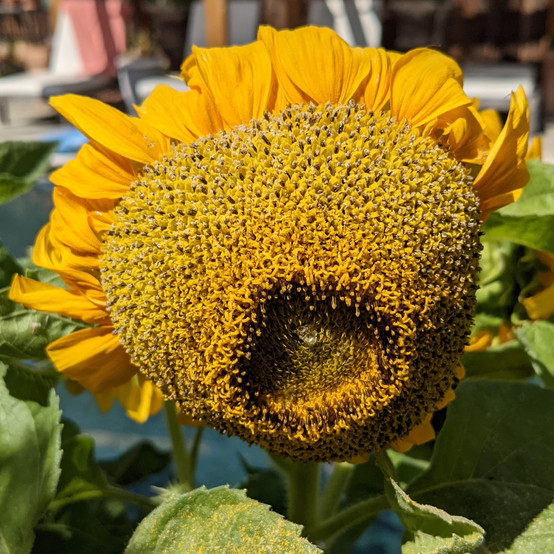Helianthus annus 'Teddy Bear'
- Admin

- Jul 20, 2021
- 3 min read
Updated: Jul 20, 2021

Apparently, no two teddy bears are alike. At least, this is my first-time experience growing Teddy Bear sunflowers. I planted six seeds with five growing successfully to maturity. Of the five, one is not behaving very teddy bearish (shown below). The grower explains that their plants are "open-pollinated," and that might explain the variability. The remaining plants exhibit shades of hirsuteness, which for my botanic exploration is refreshing to see. For designers expecting predictability, this may not be the annual for them.
This was a great choice for my planter, which is about 18" deep and 3' long. Its size allows me to plant the six seeds, and despite losing one, the others filled in nicely. H. annus 'Teddy Bear' is a dwarf, no more than 24" tall, lending itself to container growing. The Seed Savers Exchange, where I found my seeds, suggests planting a row in front of taller sunflowers to create a layered border. Good idea!
The plants are healthy and thriving, however, they do require a greater amount of water than I expected. Being in a container, they are requiring a few minutes of water everyday. By contrast, we have standard sunflowers planted in the ground that need much less, because the soil retains more moisture. Sunflowers are known to need a great amount of water while they are in their growth period, however in California, there are wayside sunflowers, particularly along I-5 in the Great Central Valley that are not receiving any supplemental water that I can observe. Small flowers and heavily branched with prolific blooms, it is unclear if roadside sunflowers are mutants from the standard species used in farming or something entirely different. More research, unless someone out there would like to share their knowledge.
For landscape architects, annuals such as sunflowers are typically excluded from designs. Space may be allocated for "seasonal color," meaning high-blooming yields presenting a splashy display for a given season. In such situations, commercial landscape maintenance companies know at certain times of the year these annuals are ripped out and replaced with something new for the upcoming season. Out with the marigolds and in with the bedding begonias kind of thing. To integrate annuals within other garden themes or landscape areas presents an additional challenge, namely that clients or gardeners are willing to go the extra mile by replacing and caring for annuals more frequently than any other plants in the landscape. Because annuals are considered high-maintenance, they are typically left out of plant specifications, including our little teddy bears.
For those of us who benefit from the reward of planting H. annus 'Teddy Bear,' well, then, plant away! Note they need full sun, lots of water, and might have bloom variability. They can be used as a cut flower, too, though given their size, cutting a stalk might mean taking the whole plant. Currently, I am floating the flower shown above, meaning I cut a short stem to leave the remaining flowers in the garden. So far, I'm enjoying its brightness indoors, and those that remain outdoors appear to have a long bloom period.
facts
Botanical Name: Helianthus annus 'Teddy Bear'
Helianthus: Greek, helios for sun and anthos for flower
Annus: Annual
Common Name: Teddy Bear sunflower
Family Name: Asteraceae
Origin: Central United States to Central America
design considerations
Positioning: Middle ground/layering, rotational crop
Garden Themes: Kitchen, cutting, cottage
Uses: Border, cut flower, mass, container, hummingbirds
identifying characteristics
Type: Summer annual
Form: Upright
Texture: Coarse
Size: 18" wide, 18"-24" tall
Outstanding Feature(s): Flower
Stem: Light green, hairy
Leaf:
Type: Simple
Arrangement: Dextrorse
Shape: Cordate
Margin: Serrate
Color: Medium to light green
Surface: Hairy
Flower: Summer. Golden-yellow up to 6" across, double, devoid of a central "eye" as with other sunflowers.
Fruit: Not observed.
cultural requirements, tolerances & problems
Sunset Zones: 4-12, 14-24; H1
USDA Zones: 2-11
Light: Full sun
WUCOLS SF Bay Area Hydro Zone: Moderate
Soil:
Texture: Sand, loam, clay, well-drained
Moisture Retention: Intermittent dryness once blooms are set
pH: Neutral to highly alkaline
Tolerances:
Problems:
Branch Strength: N/A
Insects: Caterpillars, beetles
Disease: Rust, leaf fungal spot, powdery mildew
citations & attributions
Missouri Botanical Garden. "Helianthus annus." Accessed on July 20, 2021. https://www.missouribotanicalgarden.org/PlantFinder/PlantFinderDetails.aspx?kempercode=a583.
Norris Brenzel, K. (Ed.). (2012). The New Sunset Western Garden Book. New York: Time Home Entertainment, Inc.
Water Use Classification of Landscape Species. "WUCOLS IV Plant List." University of California, Division of Agriculture and Natural Resources, Davis. Accessed on June 28, 2021.
Photos:
All photos by TELCS.












Comments